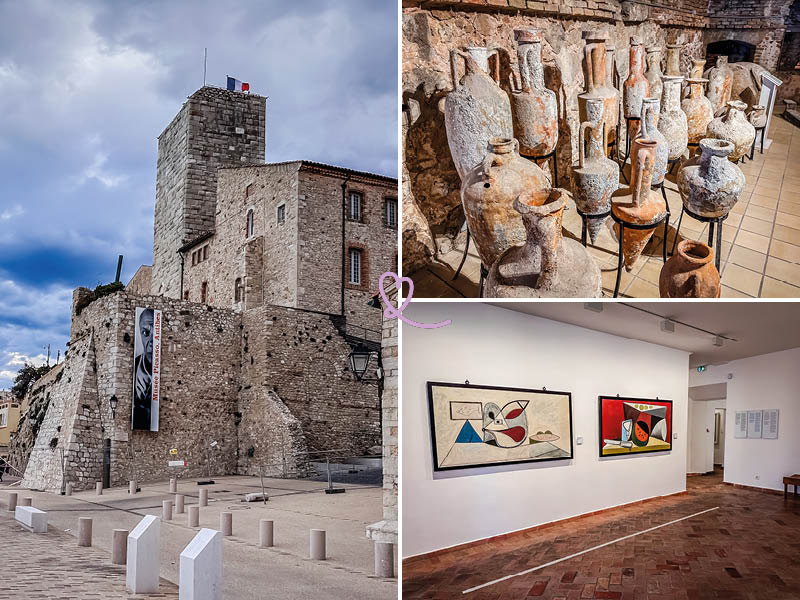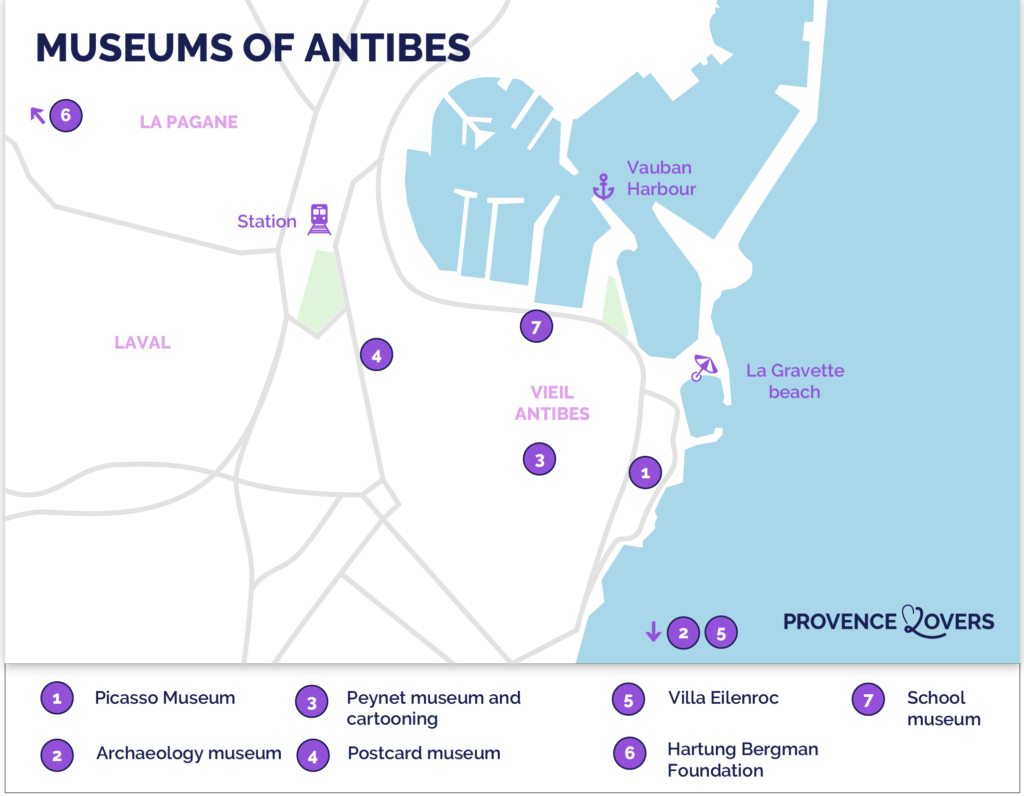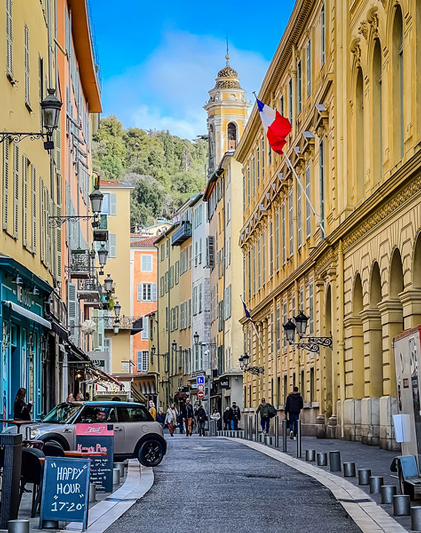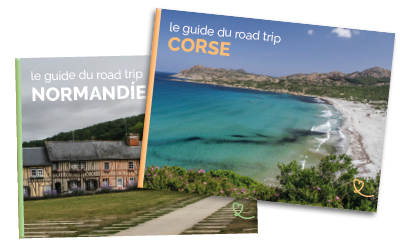Passing through Antibes? This town, located between Nice and Cannes, boasts a number of top-quality museums well worth a visit. From the most artistic (Musée Picasso), to the most original (Musée de la Carte Postale, Musée de l’École…), to the most historic (Musée d’Archéologie), there’s something for everyone!
In this article, we give you our photo tips for visiting the 7 best museums in Antibes and the surrounding area. Sharing our experiences will help you better organize your visits.
BEFORE OUR TIPS + PHOTOS
HERE ARE OUR FAVORITES ON THE Côte d’Azur East

Our favorite car rental platform: DiscoverCars

Our must-see tours:
Villa Ephrusi between Nice and Monaco
Magnificent village of Èze and Monaco from Nice or Cannes

Our unforgettable outdoor activities:
Calanques de l’Esterel by boat from Cannes
Snorkeling in Antibes
Helicopter flight from Cannes

Our favorite places to stay:
Nice: top-rated hotels e.g. Anantara Palace
Antibes: top-rated hotels e.g. Hôtel la Villa Port d’Antibes
Cannes: top-rated hotels e.g. Five Seas Hotel
Monaco: top-rated hotels e.g. Hôtel Hermitage
Menton: top rated hotels e.g. Hôtel de Londres

This guide is completely independent, based on our experiences. We visited the region anonymously, making our own choices and paying our bills in full.
Visit the best museums in Antibes: tips + map
Antibes and the surrounding area boast a large number of museums, so you’re bound to find one to suit your preferences. Why not organize your future visit around the city’s main points of interest? To help you, please refer to our article on must-do activities in Antibes.
Before diving into the in-depth analysis of each museum, we had to share our favorite spots with you!
- Musée Picasso: we’d already visited other museums dedicated to this major 20th-century artist, but it was a completely different side of Picasso that we discovered in Antibes!
- Musée Peynet et du Dessin Humoristique: we were pleasantly surprised by this museum, which gives us a better understanding of the history of caricature, from yesterday to today.
- Musée Fernand Léger in Biot: located in a neighboring commune of Antibes, this museum is a must for all contemporary art lovers.

Discover Antibes’ 7 museums, which will immerse you in the history of the town and the artists who drew inspiration from it.
Bear in mind, however, that some private museums are only open at weekends, with guided tours by appointment, or during the summer season. For ideas on what to do in Antibes in winter, see our dedicated article!
Finally, don’t forget to wear comfortable shoes, appropriate clothing and plenty of water, especially in summer!
Our favorite places

The Pass’Musées d’Antibes Juan-les-Pins
To visit the museums of Antibes Juan-les-Pins, you can opt for the Pass’Musées. It’s a great way to discover the city’s 4 major cultural sites: the Musée Picasso, the Musée d’Archéologie, the Musée Peynet et du Dessin Humoristique, and the Fort Carré. At a cost of €10, it gives you free access to these museums for 7 days, from the first time you enter one of them. In addition, it can be stored for 1 year before first use.
Antibes museum map
Here’s a map to help you find the best museums in Antibes:

1. The Picasso Museum in Antibes
Why visit it? Our review
The Musée Picasso, renamed in honor of the Spanish painter in 1966, is the town’s most important museum. It is housed in a 14th-century castle, formerly the residence of bishops in the Middle Ages, a Roman castrum, and the acropolis of the Greek city of Antipolis. The Musée d’Antibes was established in 1925, and in 1946 Pablo Picasso moved his studio there at the suggestion of the curator, before returning to Paris. Productions from this period formed the basis of the museum’s collection, which was subsequently enriched by works by other artists such as Joan Miró, Bernard Pagès and Nicolas de Staël. We were delighted to rediscover these great names in contemporary art!

The 3 things to see during your visit
Our choices are subjective, based on our artistic sensibility. Still, we’d like to share our 3 favorite moments from our visit to the museum:
- The terrace and its sculptures: the Château Grimaldi terrace overlooks the sea. We enjoyed strolling around and admiring the modern sculptures on display (works by Germaine Richier, Joan Miró…).
- Ceramics: we found it interesting to observe the artist’s experiments with this medium, which he sublimates with a naive style.
- Ulysses and the Sirens (1947) : We fell in love with this work, which revisits this famous episode from the Odyssey in a stylized, geometric style.

Practical advice
- Open Tuesday to Sunday, 10am to 1pm and 2pm to 6pm.
- Closed January 1, May 1, November 1, December 25.
- Included in the Pass’Musées d’Antibes-Juan-les-Pins.
- Suitable for children.
- Length of visit: 1 to 2 hours.
- Full adult price: €8.
- Link to the official museum website here.
WHERE TO STAY IN Antibes
Option 1: near the ramparts
Enjoy the charm of the old town and all its restaurants.
We recommend..:
- Hotel la Villa Port – prices, pictures and availability
- Hotel La Place – prices, pictures and availability

Option 2: Beachside
Around the beaches of Antibes (Ponteil and Salis), where views of the ramparts and mountains are exceptional.
We recommend..:
- Hotel La Jabotte – prices, pictures and availability

Option 3: Juan-les-Pins
If you are looking for a less classical atmosphere, stay in the heart of the old town near the main attractions.
- Hotel La Villa Cap d’Antibes – prices, pictures and availability
- Hotel Alexandra – prices, pictures and availability

2. Museum of Archaeology
Why visit it? Our review
Housed in the Saint-André Bastion, built by Vauban at the end of the 17th century, this museum presents objects from underwater and land excavations, which we found fascinating! This chronological tour begins with a look at the origins of Antibes, through relics (ceramics, bowls, etc.) attesting to the presence of the Etruscans and Greeks on Antibes territory. Then we’re plunged into Roman times. The rest of the tour is more thematic, looking at beliefs in ancient times and the differences between rural and urban life.

The 3 things to see during your visit
We were pleasantly surprised by this museum. Here are our 3 favorites from the visit:
- The Antibes pebble: dating from the 5th century BC, this is the oldest inscription from Antibes, and one of the few pre-Hellenistic Greek inscriptions discovered in the Marseille colonies.
- Wooden anchors with lead jaws: we’d never seen them before, but these massive anchors (4th-5th centuries), which succeeded stone ones and preceded iron ones, were impressive!
- Oil lamps: in ancient times, people already used oil lamps for lighting! The museum displays various types (beaker, open-channel, etc.).

Practical advice
- Open Tuesday to Sunday (March-October), and Tuesday to Saturday (November-February), 10am to 1pm and 2pm to 5:30pm.
- Closed January 1, May 1, November 1, December 25.
- Included in the Pass’Musées d’Antibes-Juan-les-Pins.
- Suitable for children.
- Length of visit: 1 to 2 hours.
- Full adult price: €3.
- Link to the official museum website here.
3. Musée Peynet et du Dessin Humoristique
Why visit it? Our review
This museum showcases the world of cartoonist Raymond Peynet (1908-1999) and some thirty other cartoonists (Daumier, Plantu, Sempé…). Raymond Peynet became world-famous for drawing a couple, later renamed the Lovers, in 1943. For 40 years, this design has been used in all kinds of media, including sculpture at the Hiroshima memorial as an international symbol of peace! The tour not only explores this history, but also the history of caricature. With over 800 drawings and archives, the collection regularly features thematic exhibitions.

The 3 things to see during your visit
We were won over by this atypical museum in the heart of Old Antibes. Here are our favorite moments of the visit:
- Peynet’s works on the city: 3 drawings on the theme of the anguish and loneliness of city life are on display, creating an interesting contrast with his usual humorous drawings.
- Crockery bearing the effigy of the Lovers: looking at these dishes, mugs and glasses, one becomes aware of “Peynetmania”.
- Contemporary exhibits: during our visit, we saw drawings by Xavier Groce, who worked for Le Monde before joining Le Point. We love his penguins with their scathing, well-informed retorts about our contemporary world.

Practical advice
- Open Tuesday to Sunday, 10am to 5pm (November-March), and 10am to 12:50pm and 2pm to 6pm (April-October). Schedules are subject to change, so please call 04 92 90 54 29/30 for further information.
- Closed January 1, May 1, November 1, December 25.
- Included in the Pass’Musées d’Antibes-Juan-les-Pins.
- Suitable for children.
- Length of visit: 1 to 2 hours.
- Full adult price: €3.
- Link to the official museum website here.
OUR TPS FOR RENTING YOUR CAR IN Provence
- Compare prices on our preferred platform: DiscoverCars – one of the best rated sites.
- Choose a car that is powerful enough (the roads are steep) but compact (some passages are narrow).
- Think of thecomplete insurance (some roads are tortuous and narrow).
- There is a lot of demand, book it early.

4. Postcard Museum
Why visit it? Our review
This atypical museum will delight postcard enthusiasts and the curious alike! A permanent audio-guided tour, complemented by temporary exhibitions, explores the evolution of postcards. The latter are also used as a “medium” to tackle social issues, such as traditional costumes in France. Finally, we were impressed by the variety of postcards on display (chocolate postcards, puzzle postcards…) and even got to see devices for creating sound cards!

The 3 things to see during your visit
Our choices are subjective, but here are the 3 things we liked best about the Musée de la Carte Postale:
- Advertising postcards: geared towards the sale of food products (champagne, pasta…), we found them amusing.
- Early 20th-century postcards by department: the museum presents postcards of people dressed in folk costumes specific to their department. It was moving to see these individuals immortalized in these vintage shots!
- The stereocard: there are several devices in the collection, but this is the one we’re most interested in. It was used to give a postcard the illusion of relief, and is in fact the ancestor of 3D!

Practical advice
- Open Tuesday to Sunday, 2pm to 6pm.
- Closed January 1 and December 25.
- Suitable for children.
- Length of visit: 1 to 2 hours.
- Full adult price: €8.
- Link to the official museum website here.
5. Villa Eilenroc
Why visit it? Our review
In the heart of Cap d’Antibes, this luxurious 19th-century villa features a park, rose garden and eco-museum. Neoclassical in style, it symbolizes the splendor of the Riviera, where a wealthy class came to spend the winter. This was the case with successive owners, from Dutchman Hugh-Hope Loudon to American Louis-Dudley Beaumont. The latter’s wife bequeathed the house to the town of Antibes for use as a reception and exhibition venue. Restored, it is now possible to visit the estate via several itineraries during the summer months.

The 3 things to see during your visit
Unfortunately, Villa Eilenroc was closed during our stay in Antibes. However, the tour is structured around..:
- of the park: it extends over 11 hectares and includes a scented garden, an olive grove, an orchard, a labyrinth and an eco-museum displaying farm tools from the 1920s. Don’t miss the 400-year-old holm oak behind the villa!
- the rose garden: inaugurated in 2003, it includes 1,000 rose plants, with all the varieties produced and commonly grown on the Côte d’Azur.
- 1st floor of the villa: this is the only part of the villa open to the public.
Practical advice
- Open only in summer, Wednesdays and Saturdays from 10am to 4pm.
- Suitable for children.
- Length of visit: 1 to 2 hours.
- Full adult price: €2.
- Link to the official website here.
A LITTLE MORE patience
All the photos, maps, information, good addresses to make your stay in Provence a success, will soon be gathered in a single ebook!
If you wish to be informed of the publication of our guide on Provence, subscribe:

6. Hartung Bergman Foundation
Why visit it? Our review
Leading figures of 20th-century abstraction, artists Hans Hartung (1904-1989) and Anna-Eva Bergman (1909-1987) acquired an olive grove in Antibes in the 1960s. On a 2-hectare site, they set up a villa and their workshops, where they lived and worked until their deaths. The foundation was created in 1994 to promote and disseminate the work of 2 artists, through exhibitions, seminars and the production of catalogs raisonnés. A visit will immerse you in a magical place where architecture is in perfect harmony with nature.

The 3 things to see during your visit
The visit is well worthwhile for lovers of contemporary art, especially abstraction:
- to discover the studios of these leading 20th-century artists!
- for temporary exhibitions: with their thematic angles, they provide a better understanding of the couple’s artistic approach.
- for the magnificent setting: the architectural complex, listed as a twentieth-century heritage site, is well worth a visit, with its uncluttered walls opening onto the superb olive grove.
Practical advice
- Open from May to September only, Monday to Friday, 10am to 6pm, by prior arrangement. Guided tour on Thursdays from 3.30pm.
- Length of visit: 1 to 2 hours.
- Full adult price: €2.
- Link to the official website here.
7. School Museum
Why visit it? Our review
This community museum presents a classroom from yesteryear, with original objects (maps, textbooks, pupils’ work…). Antibes residents can rediscover their class photos, while other visitors can rediscover the classroom materials of yesteryear (introduction to writing with quill pens and violet ink, sewing notebooks, wooden satchels…). This tour is sure to please all nostalgic fans!

The 3 things to see during your visit
Unfortunately, the museum was closed when we came to Antibes. But here’s what you can see:
- a classroom: to enter this museum is to enter a reconstructed school of yesteryear. It takes us back to the time of our parents and/or grandparents!
- archives: these consist mainly of works by former students and numerous class photos.
- school equipment: textbooks, smocks, a dust-free watering can used to sweep the classroom floor, a cross of honor, a penholder: all kinds of old items are on display.
Practical advice
- Open weekends only, from 2:30 to 5:30 pm (October – April), and from 3 to 6 pm (May – September). In July and August, the museum is only open from 3pm to 6pm.
- Length of visit: 1 to 2 hours.
- Full adult admission: free.
- Link to the official website here.
HAVE FUN WITH THESE activities
- Great kayak trips in:
Saint-Tropez to the Ramatuelle reserve
Cassis to the calanques - Helicopter flight from Cannes
- Shuttle service along the coast between Nice and Saint-Tropez
- Bike tours: eBike in Nice – Mountain biking in the Esterel massif

…And Fort Carré
Why visit it? Our review
Even if Fort Carré isn’t a museum, we couldn’t resist talking to you about this, Antibes’ best-known monument. From the railroad line that runs along the coast between Monaco, Nice and Cannes, you’re sure to catch a glimpse of it. With its famous star-shaped architecture and 4-hectare park, we were impressed! Located next to Port Vauban, this is one of the first bastioned forts built during the Renaissance. It dates back to the 16th century, when Henri II, King of France, needed a sentry to watch over the border with the Duchy of Savoy, then occupying the County of Nice.

The 3 things to see during your visit
Our choices are subjective, but we’d still like to share our 3 favorite moments from our visit:
- Panoramic views from the chemin de ronde: the chemin de ronde takes you around the monument and its 4 bastions, offering spectacular views of Old Antibes, Nice and the hinterland.
- The discovery of military graffiti: we found it moving to read the inscriptions left by the military, particularly present on the bastions.
- La Chapelle Saint-Jean: we weren’t expecting to enter such a lovely chapel on our visit. Yet it retains a remarkable polychrome decoration.

Practical advice
- Open Tuesday to Sunday, 10 am to 6 pm (June to September), and 10 am to 5 pm (September to June).
- Closed on January 1, May 1, November 1, December 25 and in bad weather.
- Suitable for children.
- Length of visit: 1 to 2 hours.
- Full adult price: €3.
- Link to the official website here.
Subscribe to our Newsletter
- Get away from it all with Region Lovers’ beautiful destinations!
- Once a month
- Advertising-free
Visits to do with children
Le Fort Carré
Fort Carré is an ideal family visit. Games and game-books on the history of the fort, or more specifically on the inscriptions left by the soldiers, are available here. Family and children’s workshops are organized on a regular basis. Visit the official website here to find out more.

Musée de l’École and Musée Peynet
We’ve listed these 2 museums because we think they might be interesting for your kids! Some of the drawings in the Musée Peynet are playful, and will amuse them. As for the Musée de l’École, it has been designed to welcome schoolchildren past and present. His goal? Create an intergenerational dialogue between children and elders, around the school.

Discovering street art
Since 2020, the Coul’Heures d’Automne Festival has been held in Antibes. Its aim is to promote urban art, and to involve local residents in questions relating to the place of art in public space. A number of works have been created for each edition of this festival, in the center of town, on the heights of Antibes, and on the Route des Plages. In addition to these monumental works, 16 miniature statuettes by Spanish artist Isaac Cordal have been hidden in the narrow streets of Old Antibes. We’re sure your kids will have lots of fun searching for them! We were particularly taken by this fresco by street artist Williann, created for the 2022 edition of the festival.

OUR TPS FOR RENTING YOUR CAR IN Provence
- Compare prices on our preferred platform: DiscoverCars – one of the best rated sites.
- Choose a car that is powerful enough (the roads are steep) but compact (some passages are narrow).
- Think of thecomplete insurance (some roads are tortuous and narrow).
- There is a lot of demand, book it early.

Other museums around Antibes
Musée National Fernand Léger in Biot
The Musée Fernand Léger is not located in Antibes itself, but in the neighboring town of Biot. If you appreciate Cubism, we highly recommend a visit to this national museum, which boasts the largest collection of works by the artist. We were pleasantly surprised by the diversity of the works on display, particularly the decorative art, and the paintings from the artist’s early career, marked by Neo-Impressionism. The museum also hosts temporary exhibitions. Find out more in our dedicated article!

Château-musée Grimaldi and Musée Renoir in Cagnes-sur-Mer
Cagnes-sur-Mer is just a 25-minute drive from Antibes. It is home to 2 very fine museums:
- The Renoir Museum: dedicated to Impressionist artist Pierre-Auguste Renoir, who spent the last 12 years of his life on a magnificent estate with panoramic views stretching as far as Cap d’Antibes!
- The Château-Musée Grimaldi: set in a medieval village, it features portraits of Suzy Solidor, an olive tree museum, contemporary art exhibitions and a superb Baroque painted ceiling.

Musée Picasso, Musée Magnelli and Musée de la Céramique in Vallauris
Vallauris, just a 20-minute drive from Vieil Antibes, is famous for having been the home of Pablo Picasso and for its ceramics production. We even talk about “Vallauris ceramics”! So it’s only natural that they should be found here:
- The Picasso Museum: located in the chapel of the Château de Vallauris, it houses La Guerre et La Paix (1952), a large-scale fresco.
- Magnelli Museum: discover the colorful abstractions of Italian painter Alberto Magnelli (1888-1971).
- The Musée de la Céramique (Ceramics Museum ): an insight into the evolution of Vallauris ceramics through various major periods.

Musée Escoffier de l’art culinaire in Villeneuve-Loubet
In Villeneuve-Loubet (11km from Antibes), discover a unique museum: the Musée Escoffier de l’Art Culinaire. The only museum of culinary art in France, it is housed in the birthplace of the famous chef and Chevalier de la Légion d’Honneur, Auguste Escoffier (1846-1935). Set in an authentic 18th-century Provencal house, the 10 rooms house a wealth of documentation on the culinary arts, table settings and a Provencal kitchen garden, as well as a collection of over 3,000 menus, from 1820 to the present day. In the room devoted to the art of pastry-making, there are even magnificent sculptures in sugar, pastillage and chocolate. This tour is sure to delight all gourmets!



